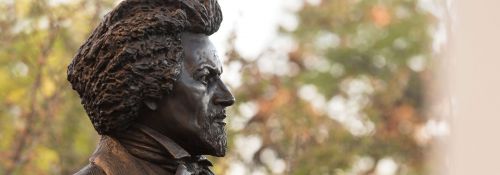
“A Man Worth Emulating:” Frederick Douglass Statue Dedicated on Hillsdale’s Liberty Walk
Commencement weekend activities began on Friday afternoon with a dedication ceremony for the latest addition to Hillsdale’s Liberty Walk—a statue of the great orator and former slave Frederick Douglass, who spoke at Hillsdale College twice, first in the midst of the Civil War in 1863 and again in 1888. Other statues on the Liberty Walk depict Washington, Jefferson, Lincoln, Churchill, Thatcher, and Reagan.
President Larry Arnn, along with sculptor Bruce Wolfe and benefactor James Nagy, unveiled the statue before a crowd of several hundred gathered in Kresge Plaza on the front campus. Dr. Lucas Morel, a professor of politics at Washington and Lee University, delivered the dedicatory address.
Noting the common description of Douglass as “majestic in his wrath,” Morel spoke of Douglass’s fierce determination not to be a “victim of his environment” and to free himself from slavery. “The soul that is within me, no man can degrade,” Douglass wrote.
Douglass believed that “the denial of an education ranked as the worst of slavery’s ills,” Morel said, and that the “key to political progress” was the spread of the principles proclaimed in the Declaration of Independence and protected by the Constitution. Though Douglass understood the vital role of “military necessity” in the abolition of slavery, it was “speech” and “not violence” that would lead to lasting “moral reformation in America.”
His embrace of universal natural rights, Morel said, led Douglass to reject the politics of racial identity. As Douglass put it, “no rights of race [are] superior to the rights of humanity.” In closing, Morel exhorted the audience to see in Douglass a man worth emulating. “In honoring Douglass, we honor the best America has to offer in service to human equality and our constitutional way of life.”
The Douglass statue stands outside of Lane Hall, opposite the Lincoln statue next to Kendall Hall, each of those statues facing the Civil War statue centered in Kresge Plaza. “Douglass looks with resolve at the soldier who paid the price,” President Arnn said. “Lincoln looks at the soldier with solemnity, almost sadness, because, of course, he was the man that gave the command that led to the last full measure of devotion.”
The statue of Frederick Douglass, Arnn concluded, represents “not just a proclamation of the evil of slavery,” but “a proclamation of the nature of man—of all of us, of what we can do, of what we’re made for.”
Printed in the Spring 2017 Alumni Magazine